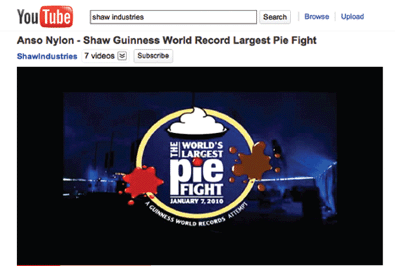By Celia Payne Marketing communications specialist, Shaw
The spotlights are turned off, the hors d’oeuvres are consumed, and the guests have dispersed. The event has come to an end. So what’s next? For many, the conclusion of a successful event marks the beginning of additional promotional opportunities made available through social media.
According to a study by en.gauge media, YouTube is the second largest search engine on the Internet, with 50% of its 300 million users visiting at least once a week. With a potential audience that large, promotionally minded manufacturers and retailers are missing a chance for significant exposure if they are not utilizing this free tool.
Shaw used YouTube to publicize its Anso nylon pie fight earlier in the year, which broke the Guinness World Record for the “Largest Pie Fight” to date. Plus, a number of Shaw customers held their own pie fights and gained additional publicity by posting their events on YouTube. To date, the Anso pie fight has had 9,554 hits on YouTube, 400 of which have been in the past week.
Events like these, as well as entertaining, homemade commercials or demonstrations of community involvement, are good subjects for YouTube broadcasts as they help consumers remember a business when shopping for new flooring.
Other social media, such as Facebook and Twitter, can be used to create fans and followers—potential customers. Monitoring these sites to learn what these consumers are thinking can also lead to more focused marketing and product selection. The growth of your Facebook or Twitter audience indicates that your content is worthwhile, and it is likely that your message will be “liked,” retweeted or blogged.
According to en.guage media, 96% of consumers age 18 to 35 belong to a social network, providing a sizeable audience that can both see and spread your message.
A good way to know if a social media plan is influencing consumer perception is to employ a call-to-action element in the content, asking friends and fans to pass along information, enter to win a contest or post their own images and comments. Just like traditional marketing, monitoring feedback and gauging the response rate of your social media efforts will help keep your message timely and consistent.
The spotlights are turned off, the hors d’oeuvres are consumed, and the guests have dispersed. The event has come to an end. So what’s next? For many, the conclusion of a successful event marks the beginning of additional promotional opportunities made available through social media.
According to a study by en.gauge media, YouTube is the second largest search engine on the Internet, with 50% of its 300 million users visiting at least once a week. With a potential audience that large, promotionally minded manufacturers and retailers are missing a chance for significant exposure if they are not utilizing this free tool.
Shaw used YouTube to publicize its Anso nylon pie fight earlier in the year, which broke the Guinness World Record for the “Largest Pie Fight” to date. Plus, a number of Shaw customers held their own pie fights and gained additional publicity by posting their events on YouTube. To date, the Anso pie fight has had 9,554 hits on YouTube, 400 of which have been in the past week.
Events like these, as well as entertaining, homemade commercials or demonstrations of community involvement, are good subjects for YouTube broadcasts as they help consumers remember a business when shopping for new flooring.
Other social media, such as Facebook and Twitter, can be used to create fans and followers—potential customers. Monitoring these sites to learn what these consumers are thinking can also lead to more focused marketing and product selection. The growth of your Facebook or Twitter audience indicates that your content is worthwhile, and it is likely that your message will be “liked,” retweeted or blogged.
According to en.guage media, 96% of consumers age 18 to 35 belong to a social network, providing a sizeable audience that can both see and spread your message.
A good way to know if a social media plan is influencing consumer perception is to employ a call-to-action element in the content, asking friends and fans to pass along information, enter to win a contest or post their own images and comments. Just like traditional marketing, monitoring feedback and gauging the response rate of your social media efforts will help keep your message timely and consistent.
 |